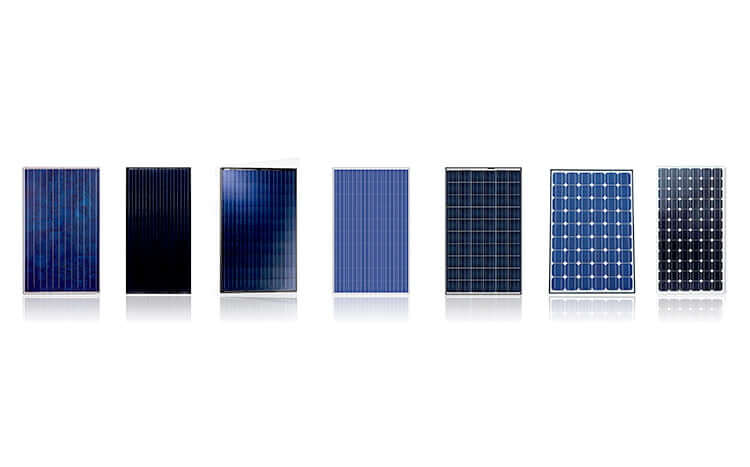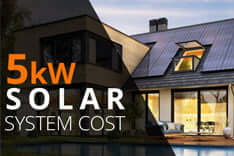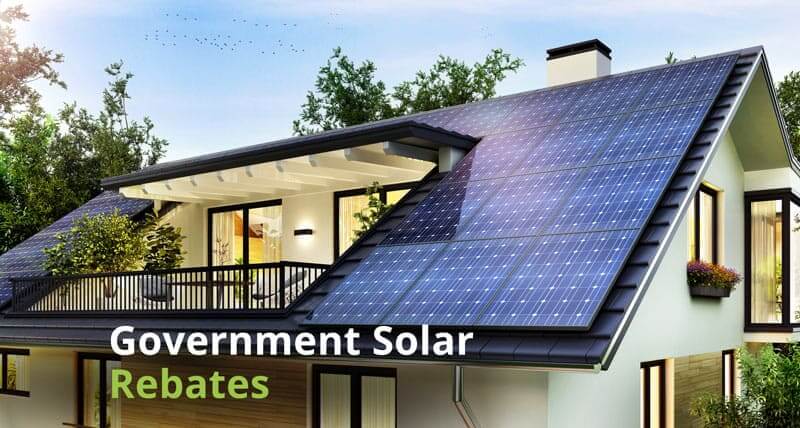Home Types of solar panels
Types of solar panels: Which is best? - Efficiency & Cost Compared
When you’re thinking about installing solar panels at your place, a major decision you’ll have to make is figuring out the best type of solar panel for your needs. This choice is crucial because it impacts the efficiency, power production, and total performance of your solar power setup.
There are three main solar panel types in the market today. They include;
- Monocrystalline solar panels
- Polycrystalline solar panels
- Thin-film solar panels.
Each of these panels displays different characteristics and thus, significantly differs in performance. Below, we dive into the details of each solar panel to help you understand which panel is best for your home.
| Solar Panel Type | Material | Efficiency | Cost | Appearance |
|---|---|---|---|---|
| Monocrystalline | Pure, single silicon crystal | High (18% or slightly higher) | $1.00 - $1.50 | Black or dark blue cells with rounded corners |
| Polycrystalline | Silicon fragments | Medium (15-17%) | $0.60 - $1.00 | Blue rectangular cells |
| Thin-Film | Amorphous silicon (a-Si) Copper Indium gallium selenide (CIGS) Cadmium telluride (CdTe) Gallium arsenide | Low (11%, but may attain 15%) | $0.50 - $0.70 | Black or blue uniform surface |
Table of Contents
ToggleThree types of solar panels
Solar panels come in various types, but most of them fit into a monocrystalline, polycrystalline, or thin film. Each type has a unique design, appearance, and features that make them ideal for specific solar projects. Below is a breakdown of the three types of solar panels.
Monocrystalline
Monocrystalline solar panels are the most developed and most efficient in the solar market. They have been in the market for a longer period, which explains their higher efficiency and development. They are also highly durable, making them an excellent choice for homeowners looking for a durable and reliable solar system.
Monocrystalline solar panels are the most popular among homeowners because of their aesthetics. Due to their pure silicone composition, these panels have a uniform, flat black color. You can easily identify mono solar panels because the cells have a square shape with cut-off corners.
Monocrystalline cells are usually considered the 1st generation and are commonly used in conventional applications. These solar panels have the highest power output and are the most expensive of the three. They cost approximately $1.00 to $1.50 per watt.
Polycrystalline
Polycrystalline solar panels are also called multi-crystalline solar panels. These panels are newer in the market, and are fast becoming popular because of their high efficiency and low cost.
These solar panels are also considered 1st generation, but they are less efficient than the monocrystalline solar panels. They are designed using many silicon fragments melted together, and their manufacturing process is faster and cheaper.
Poly solar panels cost approximately $0.90 to $1.00 per watt. The differences between poly and mono solar panels are insignificant, so your choice will depend on your preference, needs, and budget.
Poly solar panels usually have a blue hue because of the many silicon fragments. These panels do not have to cut corners and have a lower efficiency because of their manufacturing process. More so, silicon fragments do not allow electrons to roam around like in mono cells.
Thin-Film
Thin-film solar panels are different from mono and poly solar panels. They are much newer in the solar industry, and are not always designed from silicon.
Thin-film solar panels are considered 2nd generation solar panels mostly used in PV power stations, smaller solar systems, or integrated into buildings. They are the least expensive of the three options, making them a great choice for people looking for a solar system on a budget.
These solar panels cost around $0.70 to $0.90 per watt or approximately $231 to $297 per 330 watts. You can always choose a higher or lower power output depending on your needs.
Thin-film solar panels are extremely thinner than polycrystalline and monocrystalline solar panels. They can be either blue or black depending on the material used to make them.
These solar panels have a much lower efficiency than polycrystalline and monocrystalline solar panels. They are also flexible and lightweight, making them easier to install. Due to their lower efficiency rating, thin-film solar panels are mostly installed in large-scale operations.
The comparison of 3 types of solar panels
The three types of solar panels come with different features and price tags. Below is a comparison of the panels to give you a better understanding and help you make an informed decision when looking to install solar energy.
The cost of solar panels
| Type | Cost per watt | Cost per 1kW |
|---|---|---|
| Monocrystalline | $1.00 - $1.50 | $330 - $495 |
| Polycrystalline | $0.90 - $1.00 | $297 - $330 |
| Thin-Film | $0.70 - $0.90 | $231 - $297 |
Monocrystalline
Construction
Monocrystalline solar panels are designed using pure silicon, thus their name. Each set of solar cells has a silicon wafer designed from a single silicon crystal.
These solar panels are made through the Czochralski method, which involves placing a seed silicon crystal in a pure molten silicon vat. Then, the seed silicon crystal is slowly drawn from the vat, leading to the solidification of the molten silicon. This forms an ingot (a larger solidified crystal covering) around the seed crystal. The silicon ingot is cut into thin silicon wafers made into solar cells, which are assembled to create a monocrystalline solar cell.
Monocrystalline usually contains 60 to 72 solar cells depending on the panel size.
Performance
Monocrystalline solar panels have the highest performance, with a module efficiency ranging from 17% to 22%.
Since mono solar cells are designed using a single silicon crystal, electrons flow freely through the cell. This makes these solar panels have a higher efficiency than that of poly and thin-film cells. Therefore, if you plan to install a solar system, you will need fewer mono solar panels than poly and thin-film ones generating the same amount of power.
Durability
Monocrystalline solar panels are highly durable as they can last for about 25 to 30 years. Most manufacturers offer a performance warranty of 25 years, so you will have a good ROI by the time the warranty ends. Besides, the panels can continue producing electricity for a few more years after their warranty is up.
Cost
The average cost of a monocrystalline solar panel ranges between $1 to $1.50 per watt. This price is relatively higher due to the high manufacturing process of creating single silicon crystals.
Advantages
- Relatively high efficiency
- Space-efficient panels
- High life span and can be used past its warranty expiry
- Good performance in high heat and warm weather conditions
- Better aesthetics
Disadvantages
- More expensive than polycrystalline solar panels
- Potential circuit breakdown if the panel is covered by dirt, shade, or snow
- A lot of waste when silicon is being cut during the manufacturing
Polycrystalline
Construction
Polycrystalline solar panels are designed from silicon crystals, like monocrystalline solar panels. However, the silicon used here is not pure as it is obtained from fragments that are then melted together.
The seed crystal is usually put in a vat containing molten silicon, but it is not pulled out slowly like in the mono cells. Instead, the seed crystal is left to cool in its mould, forming multiple crystals. The disintegrated silicon is then sliced thinly into poly solar wafers that are assembled to create a multi-crystalline panel.
Polycrystalline solar panels tend to have a marbled blue appearance due to the multiple silicon crystals. These panels contain 60 to 72 cells like the monocrystalline solar panels.
Performance
Polycrystalline solar cells tend to have a lower efficiency than monocrystalline solar panels. This is because each solar cell contains multiple silicon crystals that do not provide electrons with enough room to move around. Poly solar panels have a module efficiency that ranges from 15% to 17%.
Nevertheless, newer poly panels have an efficiency closer to monocrystalline solar panels, thanks to advancing technology.
Durability
Polycrystalline solar panels have a shorter lifespan than monocrystalline solar panels. However, they can still last for up to 25 to 30 years with proper care and maintenance. These panels come with a warranty of 25 years on linear performance, making them an excellent investment, especially for people looking for a cheaper yet efficient option.
Cost
Polycrystalline solar cells are the most cost-effective in the market. You can expect to spend anywhere from $0.40 – $0.60 per watt. Some modern panel designs may cost you a tad higher, up to $1 per watt, but this will vary depending on the brand in use.
Advantages
- Cheaper cost per panel than Monocrystalline panels
- Durable and lasts long
- Avoids wastage of silicon during manufacturing
- Lower heat tolerance
Disadvantages
- Lower efficiency compared to monocrystalline
- Requires a larger space to achieve the desired power generation goal
- Less uniform look due to the use of lower-purity silicon
Thin-Film
Construction
Several materials are used to design thin-film solar panels. These include:
- CdTe (Cadmium telluride)
- CIGS (Copper indium gallium selenide)
- a-Si (Amorphous silicon)
- DSC (Dye-sensitized solar cells)
Each of the above materials is used to design a different type of thin-film solar cell. The thin-film a-Si solar panels utilize non-crystalline silicon (not silicone) and also contain a glass covering.
The manufacturing process of thin-film solar panels is completely different from mono and poly solar panels. Typically, the main material is placed between thin sheets of conductive material. A glass layer is then placed on top of the sheets for protection.
Thin-film solar panels are extremely lightweight and flexible, making them have a lower efficiency than crystalline solar panels.
Performance
Thin-film solar panels have the lowest efficiency in the solar market. They are, therefore, the worst in terms of efficiency, but they are also the cheapest option.
These panels have an efficiency of around 10% to 13%, which is quite low considering mono solar panels go up to 22% inefficiency. However, researchers have managed to achieve a module efficiency of 23.4% in the thin-film solar panels, so they may start swimming with the big fish soon.
Durability
Thin-film solar panels have a short lifespan due to their design. They can last for about 14 to 17 years or a little longer, but not as long as the poly and mono solar panels. However, thin-film solar panels have a much higher tolerance to heat than the other panels, making them an excellent choice for a hot climate.
Cost
Thin-film solar panels are the cheapest and easiest panels to install. You can expect to spend anywhere from $0.50 – $0.70 per watt, based on the material used in the making.
Advantages
- Power output isn’t significantly affected by high temperatures
- Thin and lightweight making installation easier
- Great performance under low light conditions
- Requires less materials during processing
- Looks clean and it’s easily bent (manageable)
- Great aesthetics
Disadvantages
- Low efficiency (almost half that of the crystalline solar panels).
- Requires more space
- Overall performance over time isn’t known since this is a new
- Technology
- Shorter lifespan
- Limited range of inverter choices
- Manufacturing may use toxic materials that aren’t environmentally friendly.
Which one is the best?
When it comes to choosing the best option for your home, you should consider the panels’ efficiency and durability.
Thin-film solar panels are relatively cheap, but they are not ideal for residential installations. This is because they will need more space and will not produce substantial electricity like the mono and poly solar panels.
Polycrystalline solar cells are a good choice for residential installations if you are on a budget. They will, however, require more space, making them unsuitable for small or complicated roofs.
That being said, monocrystalline solar panels remain the best option when you consider durability, aesthetics, and efficiency. They are, however, much costlier than the other two options.
How to choose a solar panel?
Choosing the right solar panels for your home may be a daunting experience, especially if it is your first time. Here are a few tips to guide you:
- Brand: a good solar panel brand should invest in the quality of the modules and ensure they meet the industry-standard efficiency of 18% to 18%
- Warranty: the warranty of the panels should meet the industry standard of 10-15 years
- Solar installer: it is essential to choose a high-quality and reliable local solar installation company to install your solar system. Ensure you compare the reputation and prices of several installers before choosing a particular one.
You can always seek professional help if you are unable to choose the right solar panel for your needs.
FAQ's
Who makes the most efficient solar panels?
SunPower, LG, REC, FuturaSun, and Panasonic Solar are the top 5 manufacturers of the most efficient solar panels with module efficiencies of 22.6%, 22.0%, 21.7%, 21.3%, and 21.2%, respectively. LG and SunPower solar panels use the high-purity N-type Interdigitated Back Contact (IBC) solar cells while REC uses HJT N-type cells whose efficiency is close to the IBC cells.
The efficiency of a solar panel can be influenced by factors such as temperature, interconnection, and irradiance of the cells. In some cases, the color of the panel’s back sheet can also affect the efficiency of the solar panel.
How long do solar panels last?
The industry standard lifetime of solar panels is about 25-30 years. After this period, the panels will still produce electricity at an efficiency of 75-80%. With proper care and maintenance, your solar panels can last for several more years long after their warranty is up.
Are solar panels worth it?
Yes, solar panels are a worthy investment no matter the electricity consumption rate of your household. Solar panels can considerably reduce or even eliminate your monthly electricity bills. If the area you live in has a high energy rating and can afford the initial investment, installing solar panels is a wise decision.
What are the 3 main disadvantages to solar energy?
Solar energy is an excellent choice for sustainable electricity for both commercial and residential applications. However, like any source of energy, it has several disadvantages. The three main disadvantages of solar energy include:
- High initial installation cost, which includes buying solar panels, inverters, wiring, batteries, and labor.
- It is highly weather-dependent, which means the efficiency of the panel drops during rainy and cloudy days.
- It requires a lot of space which may be inconvenient for people with limited roof space.
Nevertheless, solar energy is still a worthy investment as it can significantly cut down your electricity bills.

Table of Contents
Toggle




